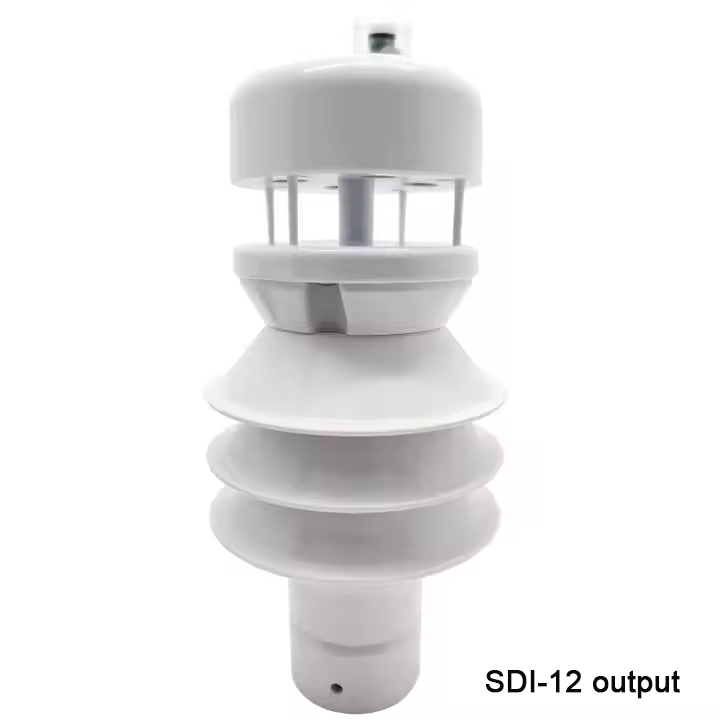In meteorological observation and environmental monitoring, it is crucial to obtain accurate and timely data. With the advancement of technology, more and more meteorological stations use digital sensors and communication protocols to improve the efficiency of data collection and transmission. Among them, the SDI-12 (Serial Data Interface at 1200 baud) protocol has become an important choice in the field of meteorological stations due to its simplicity, flexibility and efficiency.
1. Characteristics of the SDI-12 protocol
SDI-12 is a serial communication protocol for low-power sensors, suitable for a variety of environmental monitoring applications. The protocol has the following main features:
Low-power design: The SDI-12 protocol allows sensors to enter sleep mode when inactive, thereby reducing energy consumption and is suitable for battery-powered devices.
Multi-sensor support: Up to 62 sensors can be connected to an SDI-12 bus, and the data of each sensor can be identified by a unique address, which makes system construction more flexible.
Easy to integrate: The standardization of the SDI-12 protocol allows sensors from different manufacturers to operate in the same system, and the integration with the data collector is relatively simple.
Stable data transmission: SDI-12 transmits data via 12-bit digits, ensuring the accuracy and reliability of the data.
2. Composition of SDI-12 output weather station
A weather station based on the SDI-12 protocol usually consists of the following parts:
Sensor: The most important component of the weather station, which collects meteorological data through various sensors, including temperature sensors, humidity sensors, wind speed and direction sensors, precipitation sensors, etc. All sensors support the SDI-12 protocol.
Data collector: Responsible for receiving sensor data and processing it. The data collector sends requests to each sensor through the SDI-12 protocol and receives the returned data.
Data storage unit: The collected data is usually stored in a local storage device, such as an SD card, or uploaded to a cloud server via a wireless network for long-term storage and analysis.
Data transmission module: Many modern weather stations are equipped with wireless transmission modules, such as GPRS, LoRa or Wi-Fi modules, to facilitate real-time data transmission to a remote monitoring platform.
Power management: In order to ensure the long-term stable operation of the weather station, renewable energy solutions such as solar cells and lithium batteries are usually used.
3. Application scenarios of SDI-12 weather stations
SDI-12 output weather stations are widely used in many fields, including:
Agricultural meteorological monitoring: Meteorological stations can provide real-time meteorological data for agricultural production and help farmers make scientific decisions.
Environmental monitoring: In ecological monitoring and environmental protection, meteorological stations can help monitor climate change and air quality.
Hydrological monitoring: Hydrological meteorological stations can monitor precipitation and soil moisture, providing data support for water resource management and flood prevention and disaster reduction.
Climate research: Research institutions use SDI-12 weather stations to collect long-term climate data and conduct climate change research.
4. Actual cases
Case 1: An agricultural meteorological monitoring station in China
In an agricultural area in China, an agricultural meteorological monitoring system was built using the SDI-12 protocol. The system is mainly used to monitor the meteorological conditions required for crop growth. The weather station is equipped with a variety of sensors such as temperature, humidity, wind speed, precipitation, etc., which are connected to the data collector through the SDI-12 protocol.
Application effect: At the critical moment of crop growth, farmers can obtain meteorological data in real time and water and fertilize in time. This system significantly improved crop yields and quality, and farmers’ income increased by about 20%. Through data analysis, farmers can also better plan agricultural activities and reduce resource waste.
Case 2: Urban Environmental Monitoring Project
In a city in the Philippines, the local government deployed a series of SDI-12 weather stations for environmental monitoring, mainly to monitor air quality and meteorological conditions. These weather stations have the following functions:
Sensors monitor environmental parameters such as temperature, humidity, wind speed, PM2.5, PM10, etc.
The data is transmitted to the city’s environmental monitoring center in real time using the SDI-12 protocol.
Application effect: By collecting and analyzing data, city managers can take timely measures to deal with extreme climate phenomena such as haze and high temperatures. Citizens can also obtain nearby meteorological and air quality information in real time through mobile phone applications, so as to adjust their travel plans in time and protect their health.
Case 3: Hydrological Monitoring System
In a hydrological monitoring project in a river basin, the SDI-12 protocol is used to manage and monitor river flow, precipitation and soil moisture. The project set up multiple meteorological stations for real-time monitoring at different measurement points.
Application effect: The project team was able to predict flood risks by analyzing these data and issue early warnings to nearby communities. By working with local governments, the system effectively reduced economic losses caused by floods and improved the ability to manage water resources.
Conclusion
With the continuous advancement of science and technology, the application of SDI-12 protocol in weather stations has become more and more common. Its low-power design, multi-sensor support and stable data transmission characteristics provide new ideas and solutions for meteorological monitoring. In the future, weather stations based on SDI-12 will continue to develop and provide more accurate and reliable support for meteorological monitoring in various industries.
Post time: Apr-16-2025


